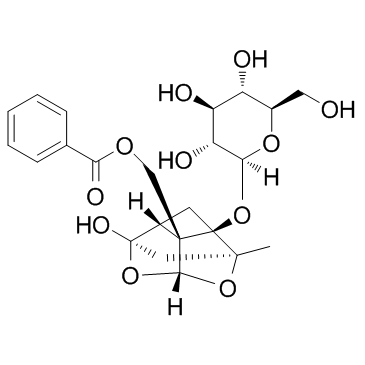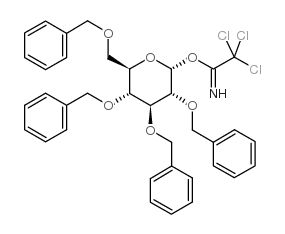Paeoniflorin

Paeoniflorin structure
|
Common Name | Paeoniflorin | ||
|---|---|---|---|---|
| CAS Number | 23180-57-6 | Molecular Weight | 480.462 | |
| Density | 1.6±0.1 g/cm3 | Boiling Point | 690.2±55.0 °C at 760 mmHg | |
| Molecular Formula | C23H28O11 | Melting Point | N/A | |
| MSDS | Chinese USA | Flash Point | 238.4±25.0 °C | |
Use of PaeoniflorinPaeoniflorin is a herbal constituent extracted from the root of Paeonia albiflora Pall.Target: OthersPaeoniflorin (PF) is the principal bioactive component of Radix Paeo- niae alba, which is widely used in Traditional Chinese Medicine for the treatment of neurodegenerative disorders such as Parkinson's disease(PD) [1]. Paeoniflorin, a compound found in white peony that inhibited the production of testosterone and promoted the activity of aromatase, which converts testosterone into estrogen [2]. Treatment of cells with paeoniflorin but not glycyrrhizin resulted in enhanced phosphorylation and acquisition of the deoxyribonucleic acid-binding ability of heat shock transcription factor 1 (HSF1), as well as the formation of characteristic HSF1 granules in the nucleus, suggesting that the induction of HSPs by paeoniflorin is mediated by the activation of HSF1. Also, thermotolerance was induced by treatment with paeoniflorin but not glycyrrhizin. Paeoniflorin had no toxic effect at concentrations as high as 80 microg/ mL (166.4 microM). To our knowledge, this is the first report on the induction of HSPs by herbal medicines [3]. |
| Name | Paeoniflorin |
|---|---|
| Synonym | More Synonyms |
| Description | Paeoniflorin is a herbal constituent extracted from the root of Paeonia albiflora Pall.Target: OthersPaeoniflorin (PF) is the principal bioactive component of Radix Paeo- niae alba, which is widely used in Traditional Chinese Medicine for the treatment of neurodegenerative disorders such as Parkinson's disease(PD) [1]. Paeoniflorin, a compound found in white peony that inhibited the production of testosterone and promoted the activity of aromatase, which converts testosterone into estrogen [2]. Treatment of cells with paeoniflorin but not glycyrrhizin resulted in enhanced phosphorylation and acquisition of the deoxyribonucleic acid-binding ability of heat shock transcription factor 1 (HSF1), as well as the formation of characteristic HSF1 granules in the nucleus, suggesting that the induction of HSPs by paeoniflorin is mediated by the activation of HSF1. Also, thermotolerance was induced by treatment with paeoniflorin but not glycyrrhizin. Paeoniflorin had no toxic effect at concentrations as high as 80 microg/ mL (166.4 microM). To our knowledge, this is the first report on the induction of HSPs by herbal medicines [3]. |
|---|---|
| Related Catalog | |
| References |
| Density | 1.6±0.1 g/cm3 |
|---|---|
| Boiling Point | 690.2±55.0 °C at 760 mmHg |
| Molecular Formula | C23H28O11 |
| Molecular Weight | 480.462 |
| Flash Point | 238.4±25.0 °C |
| Exact Mass | 480.163147 |
| PSA | 164.37000 |
| LogP | -0.42 |
| Vapour Pressure | 0.0±2.3 mmHg at 25°C |
| Index of Refraction | 1.683 |
| InChIKey | YKRGDOXKVOZESV-WRJNSLSBSA-N |
| SMILES | CC12CC3(O)OC(O1)C1(COC(=O)c4ccccc4)C3CC21OC1OC(CO)C(O)C(O)C1O |
| Storage condition | room temp |
CHEMICAL IDENTIFICATION
HEALTH HAZARD DATAACUTE TOXICITY DATA
|
| Hazard Codes | Xn,N,T,F |
|---|---|
| Risk Phrases | R22:Harmful if swallowed. R50:Very Toxic to aquatic organisms. R39/23/24/25:Toxic: danger of very serious irreversible effects through inhalation, in contact with skin and if swallowed . R23/24/25:Toxic by inhalation, in contact with skin and if swallowed |
| Safety Phrases | S61-S45-S36/37 |
| RIDADR | UN 3077 9/PG 3 |
| WGK Germany | 2 |
| RTECS | XZ3015000 |
| HS Code | 2932999099 |
|
~% 
Paeoniflorin CAS#:23180-57-6 |
| Literature: Journal of the American Chemical Society, , vol. 116, # 9 p. 4081 - 4082 |
|
~% 
Paeoniflorin CAS#:23180-57-6 |
| Literature: Journal of the American Chemical Society, , vol. 116, # 9 p. 4081 - 4082 |
|
~% 
Paeoniflorin CAS#:23180-57-6 |
| Literature: Journal of the American Chemical Society, , vol. 116, # 9 p. 4081 - 4082 |
|
~% 
Paeoniflorin CAS#:23180-57-6 |
| Literature: Journal of the American Chemical Society, , vol. 116, # 9 p. 4081 - 4082 |
|
~% 
Paeoniflorin CAS#:23180-57-6 |
| Literature: Journal of the American Chemical Society, , vol. 116, # 9 p. 4081 - 4082 |
|
~% 
Paeoniflorin CAS#:23180-57-6 |
| Literature: Journal of the American Chemical Society, , vol. 116, # 9 p. 4081 - 4082 |
|
~% 
Paeoniflorin CAS#:23180-57-6 |
| Literature: Journal of the American Chemical Society, , vol. 116, # 9 p. 4081 - 4082 |
|
~% 
Paeoniflorin CAS#:23180-57-6 |
| Literature: Journal of the American Chemical Society, , vol. 116, # 9 p. 4081 - 4082 |
| Precursor 3 | |
|---|---|
| DownStream 0 | |
| HS Code | 2932999099 |
|---|---|
| Summary | 2932999099. other heterocyclic compounds with oxygen hetero-atom(s) only. VAT:17.0%. Tax rebate rate:13.0%. . MFN tariff:6.5%. General tariff:20.0% |
|
Chemical profiling and quantification of Gua-Lou-Gui-Zhi decoction by high performance liquid chromatography/quadrupole-time-of-flight mass spectrometry and ultra-performance liquid chromatography/triple quadrupole mass spectrometry.
J. Chromatogr. B. Analyt. Technol. Biomed. Life Sci. 986-987 , 69-84, (2015) Gua-Lou-Gui-Zhi decoction (GLGZD) is a classical formula of traditional Chinese medicine, which has been commonly used to treat dysfunction after stroke, epilepsy and spinal cord injury. In this study... |
|
|
[Treatment of premenstrual syndrome with Chinese medicine formula, baixiangdan capsule: implications for neuron viability and GABA(A) receptor modulation in rat cortex].
Zhongguo Zhong Yao Za Zhi 36(11) , 1508-11, (2011) To explore the effects of Baixiangdan capsule (BXD), a Chinese medicinal formula, on the premenstrual syndrome (PMS) rats with Liver-qi invasion and the possible underlying micro-mechanisms.Wistar rat... |
|
|
Detection of paeoniflorin and albiflorin by immunostaining technique using anti-paeoniflorin monoclonal antibody.
Phytochem. Anal. 24(2) , 124-8, (2013) Paeoniae radix is one of the most important crude drugs used in Kampo medicines (KMs). A part of its pharmaceutical properties is due to the presence of paeoniflorin (PF) and albiflorin (AF).For the s... |
| paeoniflorine |
| Paeony root |
| Delmacinone |
| Paeonia moutan |
| peoniflorin |
| MFCD00869331 |
| Paeonia lactiflora P,E, |
| Paeoniflorm |
| EINECS 245-476-2 |
| PAEONIFLORIN(P) |
| ,Peoniflorin |
| PACLITAXEL |


![(2R,2aR,2a1R,3aR,4S,5aR)-2a1-((benzoyloxy)methyl)-4-methyl-3a-(prop-1-en-2-yl)hexahydro-2H-1,5-dioxa-2,4-methanocyclobuta[cd]pentalene-2-carboxylic acid structure](https://image.chemsrc.com/caspic/401/154854-74-7.png)
![(1R,3R,4R,6S,9S)-methyl 4-((R)-2-methoxy-2-phenylacetoxy)-6-methyl-1-(prop-1-en-2-yl)-7-oxatricyclo[4.3.0.03,9]nonane-9-carboxylate structure](https://image.chemsrc.com/caspic/053/154854-70-3.png)
![((1aR,1a1R,2S,3aR,5S,5aR)-5-(((benzyloxy)carbonyl)oxy)-2-methyl-1a-(prop-1-en-2-yl)tetrahydro-1H-3,4-dioxa-2,5-methanocyclobuta[cd]pentalen-1a1(3aH)-yl)methyl benzoate structure](https://image.chemsrc.com/caspic/277/154854-77-0.png)

